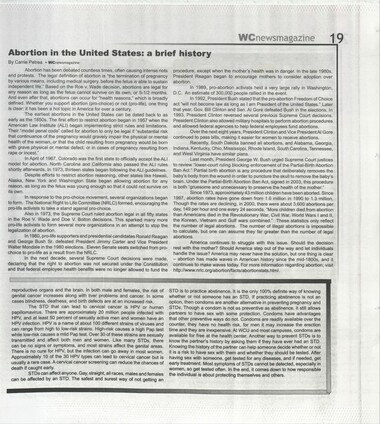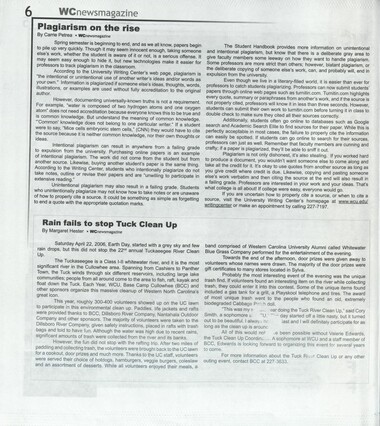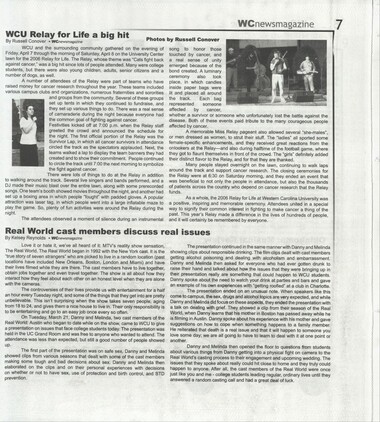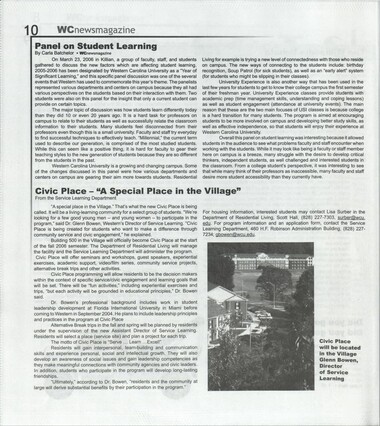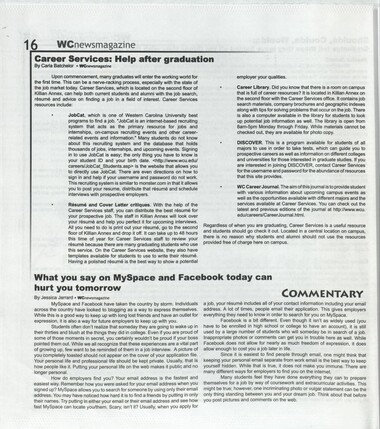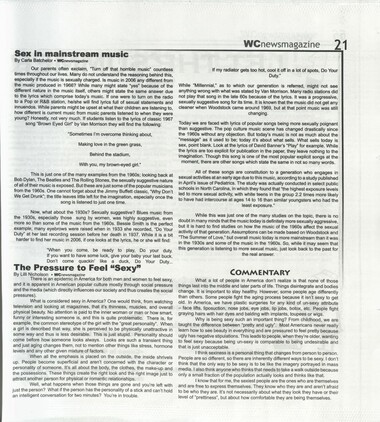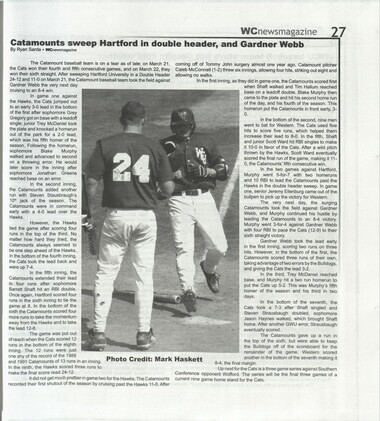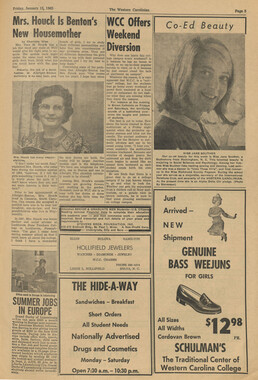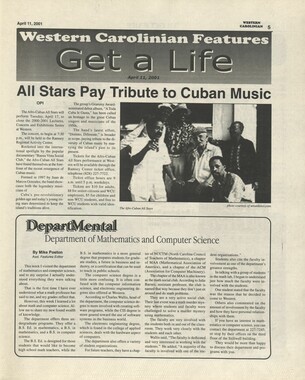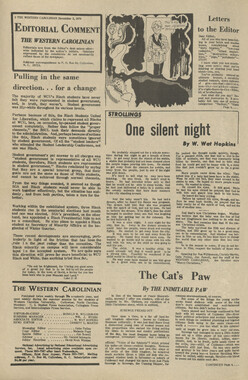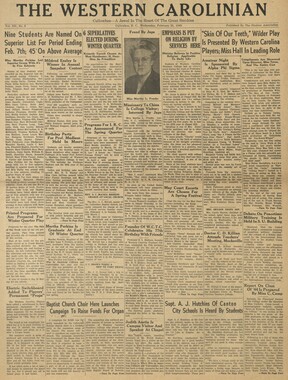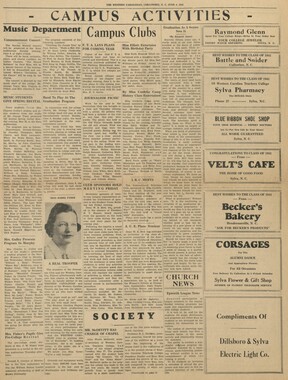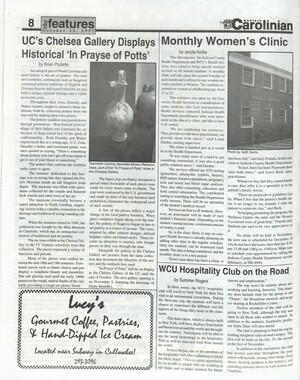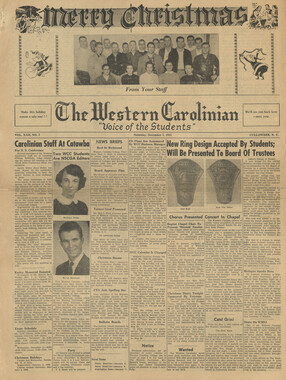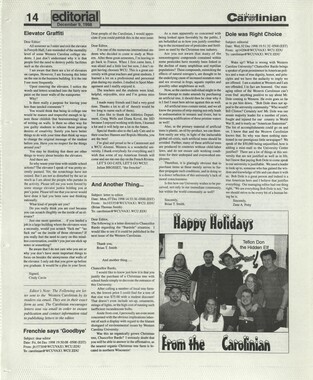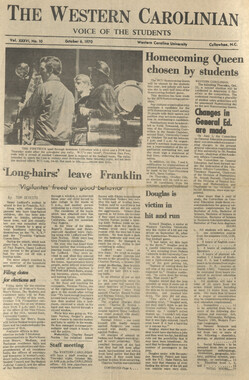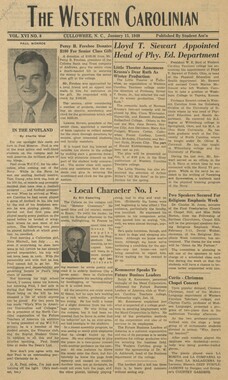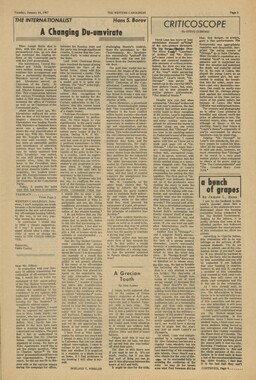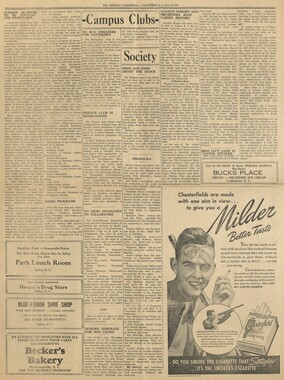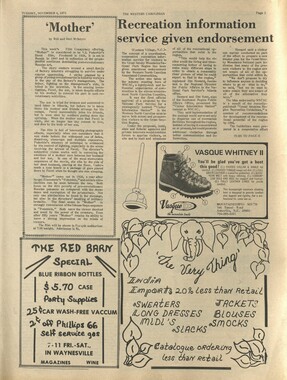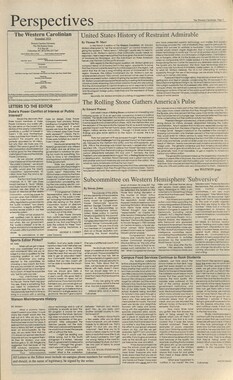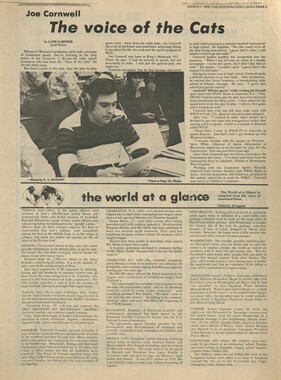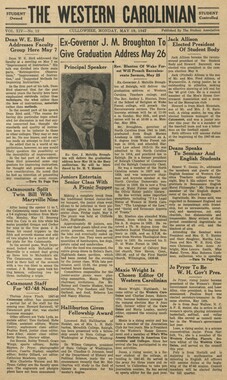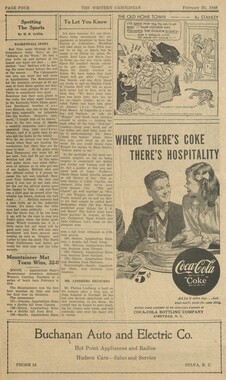Western Carolina University (21)
View all
- Canton Champion Fibre Company (2308)
- Cherokee Traditions (291)
- Civil War in Southern Appalachia (165)
- Craft Revival (1942)
- George Masa Collection (137)
- Great Smoky Mountains - A Park for America (3080)
- Highlights from Western Carolina University (422)
- Horace Kephart (998)
- Journeys Through Jackson (159)
- LGBTQIA+ Archive of Jackson County (90)
- Oral Histories of Western North Carolina (318)
- Picturing Appalachia (6617)
- Stories of Mountain Folk (413)
- Travel Western North Carolina (153)
- Western Carolina University Fine Art Museum Vitreograph Collection (129)
- Western Carolina University Herbarium (92)
- Western Carolina University: Making Memories (738)
- Western Carolina University Publications (2491)
- Western Carolina University Restricted Electronic Theses and Dissertations (146)
- Western North Carolina Regional Maps (71)
- World War II in Southern Appalachia (131)
University of North Carolina Asheville (6)
View all
- Allanstand Cottage Industries (62)
- Appalachian National Park Association (53)
- Bennett, Kelly, 1890-1974 (1463)
- Berry, Walter (76)
- Brasstown Carvers (40)
- Carver, George Washington, 1864?-1943 (26)
- Cathey, Joseph, 1803-1874 (1)
- Champion Fibre Company (233)
- Champion Paper and Fibre Company (297)
- Cherokee Indian Fair Association (16)
- Cherokee Language Program (22)
- Crowe, Amanda (40)
- Edmonston, Thomas Benton, 1842-1907 (7)
- Ensley, A. L. (Abraham Lincoln), 1865-1948 (275)
- Fromer, Irving Rhodes, 1913-1994 (70)
- George Butz (BFS 1907) (46)
- Goodrich, Frances Louisa (120)
- Grant, George Alexander, 1891-1964 (96)
- Heard, Marian Gladys (60)
- Kephart, Calvin, 1883-1969 (15)
- Kephart, Horace, 1862-1931 (313)
- Kephart, Laura, 1862-1954 (91)
- Laney, Gideon Thomas, 1889-1976 (439)
- Masa, George, 1881-1933 (61)
- McElhinney, William Julian, 1896-1953 (44)
- Niggli, Josephina, 1910-1983 (10)
- North Carolina Park Commission (105)
- Osborne, Kezia Stradley (9)
- Owens, Samuel Robert, 1918-1995 (11)
- Penland Weavers and Potters (36)
- Roberts, Vivienne (15)
- Roth, Albert, 1890-1974 (142)
- Schenck, Carl Alwin, 1868-1955 (1)
- Sherrill's Photography Studio (2565)
- Southern Highland Handicraft Guild (127)
- Southern Highlanders, Inc. (71)
- Stalcup, Jesse Bryson (46)
- Stearns, I. K. (213)
- Thompson, James Edward, 1880-1976 (226)
- United States. Indian Arts and Crafts Board (130)
- USFS (683)
- Vance, Zebulon Baird, 1830-1894 (1)
- Weaver, Zebulon, 1872-1948 (58)
- Western Carolina College (230)
- Western Carolina Teachers College (282)
- Western Carolina University (2008)
- Western Carolina University. Mountain Heritage Center (18)
- Whitman, Walt, 1819-1892 (10)
- Wilburn, Hiram Coleman, 1880-1967 (73)
- Williams, Isadora (3)
- Cain, Doreyl Ammons (0)
- Crittenden, Lorraine (0)
- Rhodes, Judy (0)
- Smith, Edward Clark (0)
- Appalachian Region, Southern (3032)
- Asheville (N.C.) (1945)
- Avery County (N.C.) (26)
- Blount County (Tenn.) (195)
- Buncombe County (N.C.) (1680)
- Cherokee County (N.C.) (283)
- Clay County (N.C.) (556)
- Graham County (N.C.) (238)
- Great Smoky Mountains National Park (N.C. and Tenn.) (535)
- Haywood County (N.C.) (3573)
- Henderson County (N.C.) (70)
- Jackson County (N.C.) (4926)
- Knox County (Tenn.) (35)
- Knoxville (Tenn.) (13)
- Lake Santeetlah (N.C.) (10)
- Macon County (N.C.) (421)
- Madison County (N.C.) (216)
- McDowell County (N.C.) (39)
- Mitchell County (N.C.) (135)
- Polk County (N.C.) (35)
- Qualla Boundary (982)
- Rutherford County (N.C.) (78)
- Swain County (N.C.) (2185)
- Transylvania County (N.C.) (270)
- Watauga County (N.C.) (12)
- Waynesville (N.C.) (86)
- Yancey County (N.C.) (72)
- Aerial Photographs (3)
- Aerial Views (60)
- Albums (books) (4)
- Articles (1)
- Artifacts (object Genre) (228)
- Bibliographies (1)
- Biography (general Genre) (2)
- Cards (information Artifacts) (38)
- Clippings (information Artifacts) (193)
- Copybooks (instructional Materials) (3)
- Crafts (art Genres) (622)
- Depictions (visual Works) (21)
- Design Drawings (1)
- Digital Moving Image Formats (2)
- Drawings (visual Works) (185)
- Envelopes (115)
- Exhibitions (events) (1)
- Facsimiles (reproductions) (1)
- Fiction (general Genre) (4)
- Financial Records (12)
- Fliers (printed Matter) (67)
- Glass Plate Negatives (381)
- Guidebooks (2)
- Internegatives (10)
- Interviews (823)
- Land Surveys (102)
- Letters (correspondence) (1070)
- Manuscripts (documents) (618)
- Maps (documents) (177)
- Memorandums (25)
- Minutes (administrative Records) (59)
- Negatives (photographs) (6090)
- Newsletters (1290)
- Newspapers (2)
- Notebooks (8)
- Occupation Currency (1)
- Paintings (visual Works) (1)
- Pen And Ink Drawings (1)
- Periodicals (194)
- Personal Narratives (10)
- Photographs (12977)
- Plans (maps) (1)
- Poetry (6)
- Portraits (4568)
- Postcards (329)
- Programs (documents) (181)
- Publications (documents) (2444)
- Questionnaires (65)
- Relief Prints (26)
- Sayings (literary Genre) (1)
- Scrapbooks (282)
- Sheet Music (2)
- Slides (photographs) (402)
- Songs (musical Compositions) (2)
- Sound Recordings (802)
- Specimens (92)
- Speeches (documents) (18)
- Tintypes (photographs) (8)
- Transcripts (329)
- Text Messages (0)
- A.L. Ensley Collection (275)
- Appalachian Industrial School Records (7)
- Appalachian National Park Association Records (336)
- Axley-Meroney Collection (2)
- Bayard Wootten Photograph Collection (20)
- Bethel Rural Community Organization Collection (7)
- Blumer Collection (5)
- C.W. Slagle Collection (20)
- Canton Area Historical Museum (2110)
- Carlos C. Campbell Collection (462)
- Cataloochee History Project (64)
- Cherokee Studies Collection (4)
- Daisy Dame Photograph Album (5)
- Daniel Boone VI Collection (1)
- Doris Ulmann Photograph Collection (112)
- Elizabeth H. Lasley Collection (1)
- Elizabeth Woolworth Szold Fleharty Collection (4)
- Frank Fry Collection (95)
- George Masa Collection (173)
- Gideon Laney Collection (452)
- Hazel Scarborough Collection (2)
- Hiram C. Wilburn Papers (28)
- Historic Photographs Collection (236)
- Horace Kephart Collection (861)
- Humbard Collection (33)
- Hunter and Weaver Families Collection (1)
- I. D. Blumenthal Collection (4)
- Isadora Williams Collection (4)
- Jesse Bryson Stalcup Collection (47)
- Jim Thompson Collection (224)
- John B. Battle Collection (7)
- John C. Campbell Folk School Records (80)
- John Parris Collection (6)
- Judaculla Rock project (2)
- Kelly Bennett Collection (1482)
- Love Family Papers (11)
- Major Wiley Parris Civil War Letters (3)
- Map Collection (12)
- McFee-Misemer Civil War Letters (34)
- Mountain Heritage Center Collection (4)
- Norburn - Robertson - Thomson Families Collection (44)
- Pauline Hood Collection (7)
- Pre-Guild Collection (2)
- Qualla Arts and Crafts Mutual Collection (12)
- R.A. Romanes Collection (681)
- Rosser H. Taylor Collection (1)
- Samuel Robert Owens Collection (94)
- Sara Madison Collection (144)
- Sherrill Studio Photo Collection (2558)
- Smoky Mountains Hiking Club Collection (616)
- Stories of Mountain Folk - Radio Programs (374)
- The Reporter, Western Carolina University (510)
- Venoy and Elizabeth Reed Collection (16)
- WCU Gender and Sexuality Oral History Project (36)
- WCU Mountain Heritage Center Oral Histories (25)
- WCU Oral History Collection - Mountain People, Mountain Lives (71)
- WCU Students Newspapers Collection (1923)
- Western North Carolina Tomorrow Black Oral History Project (69)
- William Williams Stringfield Collection (2)
- Zebulon Weaver Collection (109)
- African Americans (390)
- Appalachian Trail (35)
- Artisans (521)
- Cherokee art (84)
- Cherokee artists -- North Carolina (10)
- Cherokee language (21)
- Cherokee pottery (101)
- Cherokee women (208)
- Church buildings (190)
- Civilian Conservation Corps (U.S.) (111)
- College student newspapers and periodicals (2012)
- Dams (108)
- Dance (1023)
- Education (222)
- Floods (63)
- Folk music (1015)
- Forced removal, 1813-1903 (2)
- Forest conservation (220)
- Forests and forestry (1198)
- Gender nonconformity (4)
- Great Smoky Mountains National Park (N.C. and Tenn.) (181)
- Hunting (47)
- Landscape photography (25)
- Logging (122)
- Maps (83)
- Mines and mineral resources (9)
- North Carolina -- Maps (18)
- Paper industry (38)
- Postcards (255)
- Pottery (135)
- Railroad trains (72)
- Rural electrification -- North Carolina, Western (3)
- School integration -- Southern States (2)
- Segregation -- North Carolina, Western (5)
- Slavery (5)
- Sports (452)
- Storytelling (243)
- Waterfalls -- Great Smoky Mountains (N.C. and Tenn.) (66)
- Weaving -- Appalachian Region, Southern (280)
- Wood-carving -- Appalachian Region, Southern (328)
- World War, 1939-1945 (174)
Western Carolinian Volume 70 Number 13
Item
Item’s are ‘child’ level descriptions to ‘parent’ objects, (e.g. one page of a whole book).
-
-
Abortion in the U By Carrie Petrea + Wenewsmagazine Abortion has been debated countless times, often causing intense riots and protests. The legal definition of abortion is the termination of pregnancy by various means, including medical surgery, before the fetus is able to sustain jependent life. Based on the Roe v. Wade decision, abortions are legal for any reason as long as the fetus cannot survive on its own, or 5-1/2 months. And even after that, abortions can occur for health reasons, which is broadly defined. Whether you support abortion (pro-choice) or not (provife), one thing is clear: it has been a hot topic in America for over a century. The earliest abortions in the United States can be dated back fo as early as the 1850s. The first effort to restrict abortion began in 1957 when the American Law Institute (ALI) began implementing strict rules and limitations, Their "model penal code" called for abortion to only be legal if substantial risk that continuance of the pregnancy would gravely impair the physical or mental health of the woman, or that the child resulting from pregnancy would be born with grave physical or mental defect, or in cases of pregnancy resulting from rape or incest. In April of 1967, Colorado was the first state to officially accept the ALI made! for abortion. North Carolina and California also passed the ALI rules shortly afterwards. In 1973, thirteen states began following the ALI guidelines. Despite efforts to restrict abortion reasoning, other states like Hawaii, Alaska, New York and Washington State began allowing abortion for any reason, as long as the fetus was young enough so that it could not survive on its own. {In response to the pro-choice movement, several organizations began toform. The National Right to Life Committee (NRLC) formed, encouraging the pro-life activists to take a stand against pro-choice Also in 1973, the Supreme Court ruled abortion legal in all fifty states in the Roe V. Wade and Doe V. Bolton decisions. This sparked many more pro-life activists to form several more organizations in an attempt to stop the legalization of abortion. In 1980, pro-life supporters and presidential candidates Ronald Reagan and George Bush Sr. defeated President Jimmy Carter and Vice President Walter Mondale in the 1980 elections. Eleven Senate seats switched from pro- choice to pro-life as a result from the NRLC. In the next decade, several Supreme Court decisions were made, declaring that the right to abortion was not secured under the Constitution, and that federal employee health benefits were no longer allowed to fund the reproductive organs and the brain. In both male and females, the risk of genital cancer increases along with liver problems and cancer. In some cases blindness, deafness, and birth defects are at an increased risk. The STD that can lead to cervical cancer is HPV or human papillomavirus. There are approximately 20 million people infected with HPV, and at least 50 percent of sexually active men and women have an HPV infection. HPV is a name of about 100 diferent strains of viruses and can range from high to low-risk strains. High-risk causes a high Pap test while low-risk causes a mild Pap test. Over 30 of these strains are sexually transmitted and affect both men and women. Like many STDs, there can be no signs or symptoms, and most strains affect the genital areas. There is no cure for HPV, but the infection can go away in most women. Approximately 10 of the 30 HPV types can lead to cervical cancer but is usually a rare case. A cervical cancer screening can reduce the chances of death if caught early. STDs can affect anyone. Gay, straight, allraces, males and females can be affected by an STD. The safest and surest way of not getting an ed States: a brief history 19 WCnewsmagazine procedure, except when the mother's health was in danger. In the late 1980s, President Reagan began to encourage mothers to consider adoption over abortion. Ih 1989, pro-abortion activists held a very large rally in Washington, D.C. An estimate of 300,000 people rallied in the event. In 1992, President Bush stated that the pro-abortion Freedom of Choice act "will not become law as long as | am President of the United States. Later that year, Gov. Bill Clinton and Sen. Al Gore defeated Bush in the elections. In 1993, President Clinton reversed several previous Supreme Court decisions. President Clinton also allowed military hospitals to perform abortion procedures and allowed federal agencies to help federal employees fund abortions. Over the next eight years, President Clinton and Vice President Al Gore: continued to pass bills, making it easier for women to receive abortions, Recently, South Dakota banned all abortions, and Alabama, Georgia, Indiana, Kentucky, Ohio, Mississippi, Rhode Island, South Carolina, Tennessee, and West Virginia have similar plans. Last month, President George W. Bush urged Supreme Court justices to review lower-court ruling blocking enforcement of the Partial-Birth Abortion Ban Act. Partial birth abortion is any procedure that deliberately removes the baby's body from the wound in order to puncture the skull to remove the baby's brain. Under the Partial-Birth Abortion Ban Act, signed in 2003, this procedure is both gruesome and unnecessary to preserve the health of the mother. Since 1973, approximately 43 milion children have been aborted. Since 1997, abortion rates have gone down from 1.6 million in 1990 to 1.3 milion, Though the rates are deciining, in 2000, there were about 3,600 abortions per day, 149 per hour and one every 24 seconds. "More children died from abortion than Americans died in the Revolutionary War, Civil War, World Wars | and Il, the Korean, Vietnam and Guif wars combined. These statistics only reflect the number of legal abortions. The number of illegal abortions is impossible to calculate, but one can assume they far greater than the number of legal abortions. America continues to struggle with this issue. Should the decision rest with the mother? Should America step out of the way and let individuals handle the issue? America may never have the solution, but one thing is clear ~ abortion has made waves in American history since the mid-1800s, and it continues to make waves today. For more information regarding abortion, visit http://wmw.nric.orgiabortion/facts/abortionstats. html. STD is to practice abstinence, It is the only 100% definite way of knowing whether or not someone has an STD. If practicing abstinence is not an option, then condoms are another alternative in preventing pregnancy and STDs. Though a condom is not as preventive as abstinence, it stil allows partners to have sex with some protection, Condoms have advantages that other preventive ways do not. Condoms are readily available over the counter, they have no health risk, for men it may increase the erection time and they are inexpensive. At WCU and most campuses, condoms are available for free at the health center. Another way to prevent STDs is to know the partner's history by asking them if they have ever had an STD. Knowing the history of the partner can help someone decide whether or not itis a risk to have sex with them and whether they should be tested. After having sex with someone, get tested for any diseases, and if needed, get early treatment. Most symptoms of STDs cannot be detected, especially in women, so get tested often. In the end, it comes down to how responsible the individual is about protecting themselves and others.
Object
Object’s are ‘parent’ level descriptions to ‘children’ items, (e.g. a book with pages).
-
The Western Carolinian is Western Carolina University's student-run newspaper. The paper was published as the Cullowhee Yodel from 1924 to 1931 before changing its name to The Western Carolinian in 1933.
-
